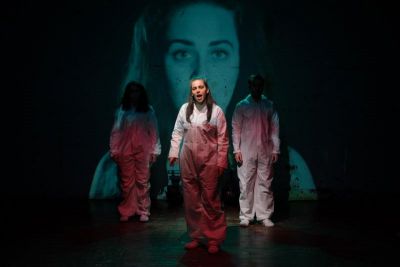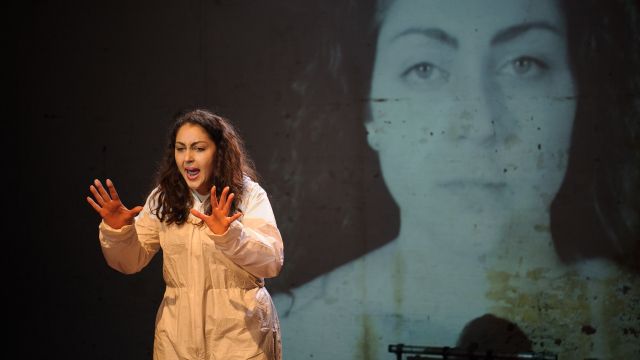Sneakyville
Sneakyville is at once a visceral experience and an intellectual and emotional challenge. It is brilliantly and inventively realised by bold and risk-taking direction, a stark, stripped back aesthetic and a cast capable of astonishing transformations. It is a play about Charles Manson – and it’s not. Remember him? It tells (but does not dramatize) in documentary detail of the murders carried out by members of the ‘Manson Family’, at Manson’s direction, in 1969 Los Angeles. The frenzied murders of not just Sharon Tate and her unborn child and four others – Jay Sebring, Abigail Folger, Wojciech Frykowski and Stephen Parent on one night - but also of Gary Inman before that, and of Leno and Rosemary LaBianca afterward.
But were this play only that, it might be ‘interesting’, in a ‘true crime’ kind of way, but not much more. Yes, ‘true crime’ is a very popular genre, but what this play sets out to do is to ask why. In this case, why were people – mostly middle-class young women - back then drawn to a petty criminal, failed musician, narcissistic sociopath and his ravings about a racial war? To his bizarre interpretations of Beatles’ songs and the Book of Revelation? They believed that he was Jesus!
 And why are people still fascinated by Manson and the horrific deeds he wrought by proxy? As director Daniel Lammin says in his program note, Sneakyville is about ‘all of us’. It’s a play about paranoia (but these days we’re wondering if ‘they’ really are out to get us) and rage – rage against the establishment, the liberals, the elite, the government, the privileged, employers, the one per cent, anyone who deprives us of what we deserve… a rage that creates violence against women, the alt-right, the revival of Nazi emblems and ideas, and a populist leader whose any action is okay – in fact, great, really great - as long as it feeds the rage. (In the July 2nd issue of The New Yorker, a cartoon has two men in a coffee shop and one says to the other, ‘I feel like I have all this anger inside but no one special to share it with.’)
And why are people still fascinated by Manson and the horrific deeds he wrought by proxy? As director Daniel Lammin says in his program note, Sneakyville is about ‘all of us’. It’s a play about paranoia (but these days we’re wondering if ‘they’ really are out to get us) and rage – rage against the establishment, the liberals, the elite, the government, the privileged, employers, the one per cent, anyone who deprives us of what we deserve… a rage that creates violence against women, the alt-right, the revival of Nazi emblems and ideas, and a populist leader whose any action is okay – in fact, great, really great - as long as it feeds the rage. (In the July 2nd issue of The New Yorker, a cartoon has two men in a coffee shop and one says to the other, ‘I feel like I have all this anger inside but no one special to share it with.’)
At the interval, after a sixty-minute Act I, you find your heart rate has increased, you are just a little breathless and can’t wait for Acts II and III although you have no idea where the play will take you next. If you’re wondering if Manson himself will appear, he already has (a soft-voiced, spooky Wil King) and the reveal of his presence is startling and pointed. For the rest of the play, Mr King almost convinces you that Charlie Manson had some real interestin’ insights into the state of things.
The level of ideas, of implied insight, perhaps drops just a little in Acts II and III. Precisely because Christopher Bryant’s writing is so rich in implication and substance, there’s a slight feeling of ‘Yes, we already know this – you’ve told us…’ But the high levels of direction and uncanny performance do not drop at all.
 Now Patrick Durnan Silva, ‘Tex’ Watson, Family member and leader of the murderers in Act I, is a call centre employee making cold calls to people who don’t want to know – and his frustration and the rage he can’t afford to have are palpable. And who else is he calling? A Family member he’s tracked down (a soft, ‘reasonable’ woman as played by Kristina Benton). And she, maybe now rueful, but not that rueful, does not assuage the rage.
Now Patrick Durnan Silva, ‘Tex’ Watson, Family member and leader of the murderers in Act I, is a call centre employee making cold calls to people who don’t want to know – and his frustration and the rage he can’t afford to have are palpable. And who else is he calling? A Family member he’s tracked down (a soft, ‘reasonable’ woman as played by Kristina Benton). And she, maybe now rueful, but not that rueful, does not assuage the rage.
Now Grace Travaglia, in Act I, scared and distressed Family member Linda Kasabian, is a heavily pregnant journalist writing a book about Manson. The task involves proximity and the need to take his pronouncements politely seriously. The pregnancy is both a reminder of Sharon Tate, an indicator of a double vulnerability and the pretext for one of the most chilling sequences in the play. You can feel the audience almost hold its breath. Meanwhile Julia Christensen is fearlessly, frighteningly Susan Atkins, a manic, unrepentant, besotted Family member, the woman who smeared ‘Pig’ in Sharon Tate’s blood on the front door.
Production design by Nathan Burmeister, the lighting design by Alexander Berlage and sound design by Kellie-Anne Kimber are all in stunning integration with and in support of text and direction. Did Ms Kimber also choose the sweet and dreamy romantic pop songs (e.g. ‘Mr Sandman, Send Me a Dream’, ‘I Don’t Want to Set the World on Fire’) that play before the show and during the interval? Was it a copyright issue not to use those Beatles’ songs? Or simply smart to resist the obvious and instead have a perfect ironic contrast to the horror show on stage?
 Why do we want Shakespeare’s Richard III to win? Why do we hope Tony Perkins in Psycho will get away with it? Christopher Bryant isn’t the first to delve into our fascination with horror, the thrill of violence and the seductions of psychopaths – but he does it with incisive originality.
Why do we want Shakespeare’s Richard III to win? Why do we hope Tony Perkins in Psycho will get away with it? Christopher Bryant isn’t the first to delve into our fascination with horror, the thrill of violence and the seductions of psychopaths – but he does it with incisive originality.
In Woody Allen’s Hannah and Her Sisters, Max von Sydow mocks the historians who ask, how could the Holocaust happen? He asks, with people as they are, why doesn’t it happen all the time?
At the end of the play, the journalist tells the audience, “We still don’t know why…’ Of course, Mr Bryant and his whole play has been telling us ‘why’ – not that it can tell us what to do about it. Not his job. But that the journalist claims not to know why suggests a central issue: do we want to know why? This is great theatre. It holds you from start to finish and is constantly surprising. And it is about something very important now.
Michael Brindley
Photographer: Sarah Walker
Subscribe to our E-Newsletter, buy our latest print edition or find a Performing Arts book at Book Nook.

